6-Wavelength High-Power LED Sources
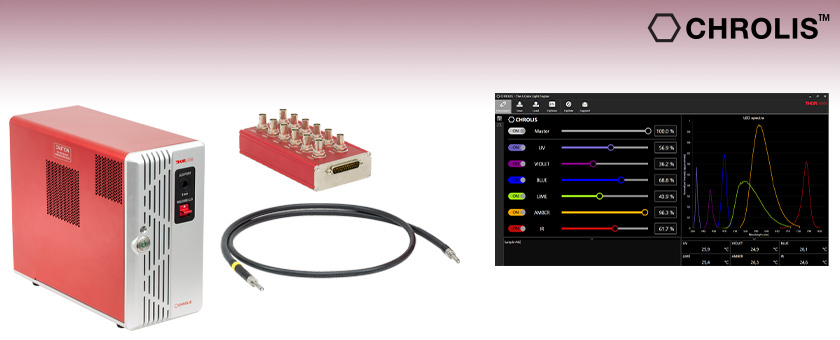
- 6-Wavelength LED Sources with Stable and Repeatable Emission
- LEDs Controlled via Easy-to-Use GUI
- Choose from 11 LEDs for Custom Configurations
- Breakout Box Available for Timing with External Devices
CHROLIS-C1
6-Wavelength High-Power LED Source
with Included LLG03-4H Liquid Light Guide
BBC1
Breakout Box
(Sold Separately)
The Chrolis software allows users to set the power level and define the pulse lengths, pulse timings, and internal and external trigger signals for each LED independently.

Please Wait
| Table 1.1 LED Options | ||
|---|---|---|
| Nominal Wavelength |
Color (Click for Spectrum) |
Typical Output Powera |
| 365 nm | UV | 1130 mW |
| 385 nm | UV | 1250 mW |
| 405 nmb | UV | 900 mW |
| 420 nmb | Violet | 710 mW |
| 475 nm | Blue | 630 mW |
| 490 nm | Blue | 120 mW |
| 525 nmc | Green | 180 mW |
| 565 nmc | Lime | 350 mW |
| 590 nm | Amber | 140 mW |
| 625 nm | Red | 490 mW |
| 780 nm | IR | 40 mW |
Features
- Combine 6 User-Changeable, High-Power LEDs into One Liquid Light Guide
- Eleven Wavelength Options Cover All Known Fluorophores Between 365 nm and 780 nm
(See Table 1.1) - USB 2.0 Interface
- Control LEDs Using Included Software with GUI (See the Software Tab for Details)
- Individually Modulate LEDs for Pulsed Light Applications
- Integrated Cooling System for Extending Liquid Light Guide's Lifetime
- Typical Lifetime of LED Modules is ≥10,000 Hours (See the Specs Tab for Details)
- Breakout Box for External Modulation and Triggering Other Devices (Sold Separately Below)
- User-Configurable LED Sources Available Through the Tool Below
Thorlabs' Chrolis™ 6-Wavelength High-Power LED Sources are ideal for fluorescence imaging or any other application that requires up to six wavelengths of light. These user-configurable light engines efficiently combine the output of all six LEDs into a single liquid light guide (LLG); Thorlabs' LLG03-4H LLG is included. Compared to conventional non-LED sources like halogen and gas discharge lamps, these mercury-free 6-wavelength light sources offer many advantages such as higher signal-to-noise ratios (due to narrow bandwidth emission), high stability (see the Stability tab), longer life, and lower replacement costs. The Chrolis LED sources are available in two pre-set configurations; user-configured LED sources can also be ordered using the tool below.
The Chrolis light engines are designed to couple light into a Ø3 mm core liquid light guide (LLG). The typical output power for each LED from the included LLG03-4H LLG is shown in Table 1.1. Each light source is equipped with an integrated cooling system that cools the tip of the LLG using thermoelectric coolers (TECs), thus extending the LLG lifetime. The optical output port for the LLG, LLG release lever, and On/Off button are located on the front of the housing for easy access.
The side panel is engraved with the LED schematic and spaces for the user to record the installed LEDs, as shown in Figure 1.2. Users can easily remove this panel by unscrewing the five setscrews with a 2 mm (5/64") hex key and access the LED and dichroic mirror modules. To remove LED modules, press the locking pin handle and turn toward "OPEN", then pull outward. Dichroic mirror modules are secured by magnets and can be removed by pulling outward on the handle. The modules are mounted on an actively cooled heat sink and the temperature of the LED modules is continuously monitored to ensure highly stable performance. Each LED module also has a removable SM1-threaded filter holder that is magnetically held in place in front of the LED. This feature provides space for Ø1" (Ø25 mm) bandpass filters up to 0.248" (6.3 mm) thick to be inserted in the Chrolis light paths and restrict the spectrum emitted by each LED. For instructions on inserting bandpass filters, please refer to the Chrolis Operation Manual available by clicking the Docs icon (![]() ) below.
) below.
Every 6-wavelength LED source includes a software package with an easy-to-use GUI; see the Software tab for more details. Once the light source is connected via a USB interface, this intuitive software can detect the LED configuration and display the corresponding LED spectra. Users can set the intensity of each LED as well as modulate them for pulsed light applications. A different pulse train can be defined for each LED, with an allowable on/off time of 5 µs to 71 minutes; see Figure 1.2. For externally triggering the LEDs, we offer a breakout box that can be configured with the Chrolis software. LED pulse trains can be linked in the software such that a single external trigger will initiate a user-defined pulse sequence for up to six LEDs.

Click for Details
Click Here for Full-Sized Image
Figure 1.3 Composite (a) and montage (b) images of GATTA-Cells 4C Human Fibroblast cells (huFIB) acquired using a custom Cerna® Microscope with the CHROLIS-C1 LED Source and CS505MU Camera. The full-size downloads of these images should be viewed using ThorImage®CAM, ImageJ, or other scientific imaging software. They may not be displayed correctly in general-purpose image viewers. (Courtesy of the Lab of Dr. Peter Stys, University of Calgary.)
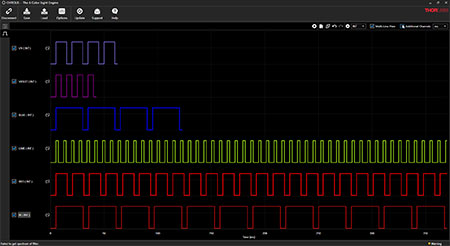
Click to Enlarge
Figure 1.2 Users can modulate individual LEDs using the Chrolis software. The GUI displays the user-defined pulse trains for each LED.
Pre-Set and Custom Configurations
Two pre-set Chrolis light source configurations are available from stock. The six wavelengths included in each source were selected to support common fluorescence microscopy and optogenetics applications.
Chrolis 6-wavelength LED sources with user-selected LED wavelengths can be configured using the tool below. The available LED wavelengths are listed in Table 1.1. Due to the optical configuration, LEDs with closely overlapping spectra (specifically, 405/420 nm and 525/565 nm) cannot be combined in the same source; all other LED combinations are allowed. The appropriate dichroic mirrors and LED positions are pre-set based on the user-selected wavelengths for each source.
If you desire an LED configuration other than those available below, such as a source with fewer than six LEDs, please contact Tech Support.
| LED Specifications | ||||||||
|---|---|---|---|---|---|---|---|---|
| Nominal Wavelengtha | Peak Wavelength | Color (Click for Spectrum) |
Typical Output Powerb |
Bandwidth (FWHM) |
Lifetime (Typ.) |
|||
| Min | Typ. | Max | ||||||
| 365 nm | 360 nm | 365 nm | 370 nm | UV | 1130 mW | 9 nm | >1 000 h | |
| 385 nm | 380 nm | 385 nm | 390 nm | UV | 1250 mW | 11 nm | >1 000 h | |
| 405 nmc | 400 nm | 405 nm | 410 nm | UV | 900 mW | 12 nm | >1 000 h | |
| 420 nmc | 415 nm | 420 nm | 425 nm | Violet | 710 mW | 14 nm | >10 000 h | |
| 475 nm | 465 nm | 475 nm | 485 nm | Blue | 630 mW | 23 nm | >10 000 h | |
| 490 nm | 480 nm | 490 nm | 500 nm | Blue | 120 mW | 23 nm | >1 000 h | |
| 525 nmd | 510 nm | 520 nm | 530 nm | Green | 180 mW | 38 nm | >10 000 h | |
| 565 nmd | 560 nm | 565 nm | 570 nm | Lime | 350 mW | 100 nm | >10 000 h | |
| 590 nm | 590 nm | 595 nm | 605 nm | Amber | 140 mW | 80 nm | >10 000 h | |
| 625 nm | 625 nm | 633 nm | 640 nm | Red | 490 mW | 13 nm | >10 000 h | |
| 780 nm | 770 nm | 780 nm | 790 nm | IR | 40 mW | 28 nm | >10 000 h | |
| Chrolis Light Source Specifications | |
|---|---|
| Internal Modulation (Square Wave Only) | |
| Typical Rise and Fall Time (10% - 90%) | 2 µs |
| On Time of LED Pulse (Min to Max) | 5 µs to 71 minutes |
| Off Time of LED Pulse (Min to Max) | 5 µs to 71 minutes |
| Range of Number of Pulses | 1 to 4.2 x 109 or Infinite |
| General | |
| Output Coupling | Ø3 mm Liquid Light Guide (LLG03-4H Included) |
| Compatible Bandpass Filter Size | Ø1" (Ø25 mm), Up to 0.248" (6.3 mm) Thick |
| PC Interface | Full-Speed USB 2.0 (12 Mbps) (USB Cable Included) |
| Power Supply | 100 V - 120 V / 200 V - 240 V 50 - 60 Hz |
| Operating Temperature | 0 °C to 35 °Ca |
| Storage Temperature | -40 °C to 70 °C |
| Dimensions | 297.7 mm x 130.0 mm x 251.5 mm (11.72" x 5.12" x 9.90") |
| Weight | 7.7 kg (17.0 lbs) |
| DSUB25 Connector for BBC1 Breakout Box Specifications | |
|---|---|
| External Modulation (TTL) | |
| Typical Rise and Fall Time (10% - 90%) | 2 µs |
| Typical Trigger Delay | 1 µs |
| LED Input Connectors | |
| Input Impedance | 2 kΩ (Internal Pullup to 5 V) |
| Max Input Voltage | 5 V |
| Low Voltage | 0 V - 0.8 V |
| High Voltage | 2.0 V - 5.0 V |
| AUX Connectors | |
| Impedance | 50 Ω |
| Max Input Voltage | 5 V |
| Input Low Voltage | 0 V - 0.8 V |
| Input High Voltage | 2.0 V - 5.0 V |
| Output Voltage | TTL Level |
| Max Output Current | 25 mA |
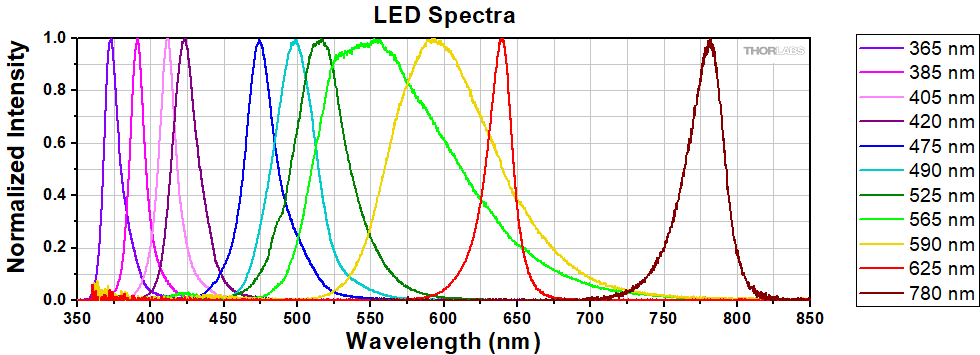
Figure 3.1 This graph shows the normalized output spectra for each LED module and does not represent the relative LED power that will be output from the Chrolis.
LED Short-Term and Long-Term Power Stability
The thermal management of the Chrolis LEDs has been optimized to provide stable power output. The stability of the CHROLIS-C2 LED modules was tested over a 24 hour period with each LED in CW mode at maximum intensity. The LED output power was monitored with an S142C Integrating Sphere Photodiode Sensor connected to a PM100USB Power Meter Interface. As shown in these plots, the LED modules maintained stable power levels throughout the time period. Over the first 5 minutes, each LED experienced a small power drop on the order of 1 to 2%, which corresponds to the period of time required for the LED to warm up to the point where it is thermally stable. After warm up, the typical variations in output power were smaller than 0.5%.
| Table 5.1 Recommended System Requirements | |
|---|---|
| Operating System | Windows® 8.1 (32-Bit, 64-Bit) Windows® 10 (32-Bit, 64-Bit) Windows® 11 |
| Processor (CPU) | 2.4 GHz or Higher |
| Memory (RAM) | 4 GB |
| Graphics Card | Min 1024 x 768 Pixels |
| Hard Disk | Min 1 GB of Available Free Disk Space (32-Bit Operating System) Min 2.3 GB of Available Free Disk Space (64-Bit Operating System) |
| Interface | Free USB 2.0 Port, USB Cable According to the USB 2.0 Specification |
Software for the Chrolis™ 6-Wavelength High-Power LED Sources
The Chrolis software allows the user to individually control each LED via an easy-to-use GUI. The Chrolis light source connects to a PC through a USB interface; see Table 5.1 for recommended system requirements. The intuitive software can detect the connected light source and the LED configuration, as shown in Figure 5.2. The Settings tab displays the position, nominal wavelength, and color of the six installed LEDs. The user also has the option to input custom names for each LED, which can be used as the LED labels in other tabs. All of the user-defined settings can be exported as an XML file and loaded back into the software for future uses to ensure consistency between experiment runs.
The LEDs can be activated in the Continuous Wave (CW) or Pulsed Mode Master Tabs, which are located on the left side in the main screen below the "Disconnect" button; see Figures 5.3 and 5.4. In both modes, the power level of each LED can be set to a certain percentage. Figure 5.4 shows the Master tab in the CW mode. The master power slider will change the power of all LEDs simultaneously while keeping the ratio constant. A plot of each LED spectrum is displayed to the right of the power sliders. The temperature of every LED is monitored and shown under the spectra plot. If one LED exceeds 90 °C, all LEDs will turn off automatically. To turn on the light source, the user must toggle the individual power switch of each LED to "ON" and then toggle the master power switch to "ON".
In Pulsed mode, the user can trigger LEDs with internally or externally generated signals. The Pulsed mode Master tab allows different pulse lengths and pulse timings to be defined for each LED. As shown in Figure 5.4, the Master tab will display a plot of each defined pulse train for a visual comparison of the different signals. The user can set the following parameters: signal polarity, power, delay time, duty time, idle time, and number of cycles. For external pulse generation, the BBC1 breakout box (sold separately) and a user-supplied input signal generator is required. The BBC1 breakout box connects to the Chrolis light source via the included DSUB25 cable and the input signal generator connects to the BBC1 box via one of the BNC connectors marked LED 1 to LED 6.
In the Pulsed mode Master tab, the BBC1 breakout box's additional channels can also be configured. The user can set the six BNC connectors labeled AUX 1 through AUX 6 as either an input or output. These channels can be used to generate trigger signals for other devices like cameras or initiate internal pulse generation for a specific LED. The software also allows the user to create links between channels. This can be used to start LED pulses with a certain delay
after receiving a trigger pulse. For instructions on how to configure the breakout box with the Chrolis software, please see the Chrolis software manual.
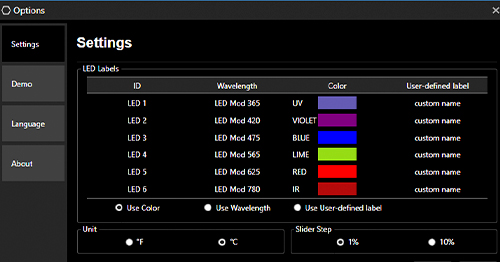 Click to Enlarge
Click to EnlargeFigure 5.2 The Chrolis software intuitively detects the LED configuration. In the Settings Window, the installed LED modules are listed, identifying each module's position, nominal wavelength, and color.
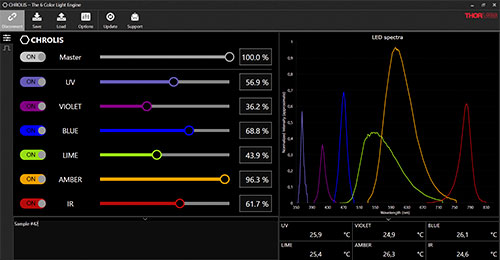 Click to Enlarge
Click to EnlargeFigure 5.3 The power level of every LED can be set to a certain percentage. The Master tab in CW mode displays each LED's power level, spectra, and temperature.
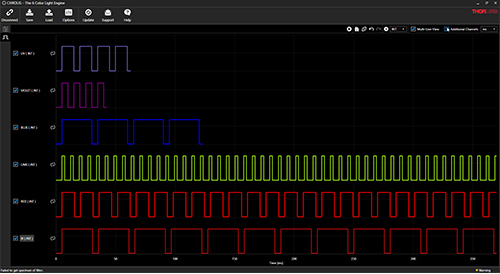 Click to Enlarge
Click to EnlargeFigure 5.4 Users can modulate individual LEDs using the Chrolis software. The Maser tab in Pulsed mode shows the unique pulse trains for each LED.
| Posted Comments: | |
user
(posted 2025-10-03 22:47:26.24) When using continuous output, do I still need to start up the computer each time? It's a hassle, so I'd like to be able to use it just by turning on the unit itself. If I set the wavelength and intensity once on the computer, can't I use the previous settings next time without starting up the computer? jjadvani
(posted 2025-10-06 09:58:58.0) Dear user, Thank you contacting Thorlabs. CHROLIS LED can only be controlled with software. When using an external breakout box, further software configuration is required. Thus, Chrolis cannot be controlled without turning on the PC. user
(posted 2025-07-23 21:13:09.433) Would it be possible to have a 340 nm LED added as a custom option together with the 385 nm LED for better dynamic range when using Fura-2? jjadvani
(posted 2025-07-24 03:06:56.0) Dear user, We appreciate your interest in our product. I will contact you directly with information about the possibilities of this custom configuration. Michael Moore
(posted 2023-10-27 15:38:30.483) Is it possible to insert an excitation filter before coupling into the liquid light guide? jweimar
(posted 2023-11-03 04:28:53.0) Dear Michael, thank you for your inquiry. Yes, it is possible to insert Ø1" (Ø25 mm) filters. The filter can be placed in the front part of the LED module. Arthur Fogiel
(posted 2023-10-19 08:02:40.107) Is it possible to interface with the system over Linux? We would prefer to directly connect the box to an instrument which is linux based to both reduce the need for an external PC as well as have tighter timings to our instrument. There is mention of windows drivers but does it use a virtual serial port that Linux could talk to? dpossin
(posted 2023-10-20 07:24:56.0) Dear Arthur,
Thank you for your inquiry. Unfortunately since the CHROLIS does not support SCPI commands we see no way how it could be controlled on a linux based program. I am sorry for the inconvenience. Samuel Harris
(posted 2023-05-18 09:55:10.1) Hi would it be possible to send me an SDK so that our Chrolis device may be controlled using custom written software? Many thanks. wskopalik
(posted 2023-05-19 10:08:05.0) Thank you very much for your feedback!
The SDK is included in the current installation package for the Chrolis which can be downloaded here on the website. The locations of the necessary file (e.g. DLL and header files) are listed in the chapter “Write Your Own Application” in the manual.
I will contact you to provide further assistance. user
(posted 2023-01-31 23:29:26.6) Is it possible to modulate the CHROLIS LEDs with sinusoidal external signals? Or is TTL the only option? hkarpenko
(posted 2023-02-02 08:12:16.0) Dear customer,
thank you very much for your feedback.
Unfortunately it´s only possible to modulate the CHROLIS LED driver using a TTL signal. This is possible either internally or externally using the BBC1 (breakout box) sold seperately. I will contact you directly to discuss this further with you. Nick Anthony
(posted 2021-10-01 16:12:38.907) Is there an SDK or documentation for serial commands so that this device can be controlled in custom software? wskopalik
(posted 2021-10-14 04:00:32.0) Thank you for your feedback!
Yes, we can provide an SDK.
I will contact you directly to provide further information and assistance. user
(posted 2021-09-27 18:14:03.367) Would it be possible to choose LED's that ARE sold by Thorlabs, but are not a part of the drop-down menu provided on the website? soswald
(posted 2021-09-28 05:44:11.0) Dear customer,
thank you for your feedback. We may be able to offer custom configurations with other LEDs than the ones listed, although this depends on your individual requirements.
I have reached out to you directly to discuss your application in more detail. Laerte Patera
(posted 2021-02-09 15:02:23.02) I am looking for a multiple wavelength/high power LED source with external trigger, which should provide pulses of about 1-2 us at about 60 kHz rep rate.
Would it be possible with the CHROLIS?
Many thanks!
Regards,
Laerte MKiess
(posted 2021-02-11 08:57:59.0) Dear Laerte, thank you very much for your inquiry.
The typical rise and fall time, if you want to modulate the LEDs externally, via TTL signal is 2µs. This corresponds to an approximate bandwidth of 175kHz (0.35/rise time). Depending on which pulse shape and modulation depth, the LED pulse should have, this is possible, depending on the application. I have contacted you directly to discuss the further details. |
This tab includes all LEDs sold by Thorlabs. Click on More [+] to view all available wavelengths for each type of LED pictured below.
| Light Emitting Diode (LED) Selection Guide | |||||
|---|---|---|---|---|---|
| Click Photo to Enlarge (Representative; Not to Scale) |
 |
 |
 |
 |
 |
| Type | Unmounted LEDs | Pigtailed LEDs | LED Arrays | LED Ring Light | Cage-Compatible Diffuse Backlight LED |
| Light Emitting Diode (LED) Selection Guide | ||||||
|---|---|---|---|---|---|---|
| Click Photo to Enlarge (Representative; Not to Scale) |
 |
 |
 |
 |
 |
 |
| Type | PCB- Mounted LEDs |
Heatsink- Mounted LEDs |
Collimated LEDs for Microscopyb | Fiber- Coupled LEDsc |
High-Power LEDs for Microscopy | Multi-Wavelength LED Source Optionsd |

- Two Pre-Configured Chrolis LED Sources
- Designed for Applications in Fluorescence Microscopy and Optogenetics
- Liquid Light Guide, USB Cord, and Region-Specific Power Cord Included
We offer two pre-configured Chrolis 6-wavelength LED source options. Each light source comes with six LED modules and five dichroic mirror modules (see Table G1.1 for details). The CHROLIS-C1 and CHROLIS-C2 LED sources are designed for applications in fluorescence microscopy and optogentics.
These light engines are shipped with a LLG03-4H LLG, USB cord, and a region-specific power cord.
To order a custom configuration containing up to six of the LED options listed in the Overview tab, see the configuration tool.
| Table G1.1 Key Specifications | ||||
|---|---|---|---|---|
| Item # | CHROLIS-C1a | CHROLIS-C2a | ||
| LED Position | Nominal Wavelength | Typical Output Powerb | Nominal Wavelength | Typical Output Powerb |
| LED1 | 365 nm | 930 mW | 385 nm | 1100 mW |
| LED2 | 405 nm | 830 mW | 420 nm | 700 mW |
| LED3 | 475 nm | 530 mW | 475 nm | 450 mW |
| LED4 | 565 nm | 330 mW | 525 nm | 170 mW |
| LED5 | 625 nm | 510 mW | 590 nm | 100 mW |
| LED6 | 780 nm | 50 mW | 625 nm | 580 mW |
| Dichroic Mirror Position | Cut-On Wavelength | Cut-On Wavelength | ||
| D1 | 397 nm | 397 nm | ||
| D2 | 458 nm | 458 nm | ||
| D3 | 506 nm | 506 nm | ||
| D4 | 605 nm | 562 nm | ||
| D5 | 735 nm | 605 nm | ||
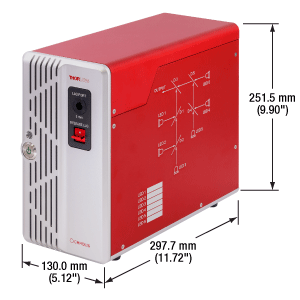
Click to Enlarge
Figure G1.2 Dimensions of the Chrolis LED Sources
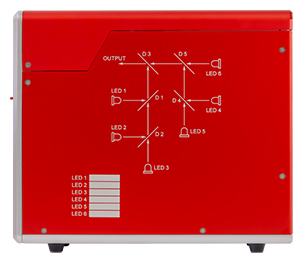
Click to Enlarge
Figure G1.3 The side panel of the Chrolis light source is engraved with the LED schematic. White labels are provided to allow users to record which LEDs are installed.
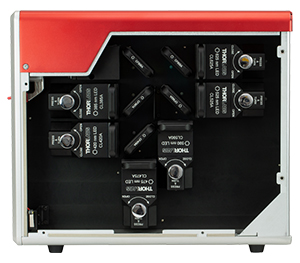
Click to Enlarge
Figure G1.4 The LED Configuration of the CHROLIS-C2 Light Source

Chrolis 6-wavelength LED sources with user-selected LED wavelengths can be configured using this tool. Use the dropdown menus to select the desired wavelength for each LED slot. Due to the optical configuration, LED slots must be filled from the longest to the shortest wavelength (LED 6 through LED 1). Only a subset of the 11 available LEDs are offered as options for each slot (for example, the shortest wavelength LEDs cannot be assigned to LED 6), and LEDs with closely overlapping spectra (specifically, 405/420 nm and 525/565 nm) cannot be combined in the same source. As each LED is selected, the remaining dropdown menus will update so that only supported wavelength combinations are shown. The appropriate dichroic mirrors and LED positions are pre-set based on the user-selected wavelengths for each source.

| BBC1 Specifications When Used with a Chrolis Source | |
|---|---|
| External Modulation (TTL) | |
| Typical Rise and Fall Time (10% - 90%) | 2 µs |
| Typical Trigger Delay | 1 µs |
| LED Input Connectors | |
| Input Impedance | 2 kΩ (Internal Pullup to 5 V) |
| Max Input Voltage | 5 V |
| Low Voltage | 0 V - 0.8 V |
| High Voltage | 2.0 V - 5.0 V |
| Aux Connectors | |
| Impedance | 50 Ω |
| Max Input Voltage | 5 V |
| Input Low Voltage | 0 V - 0.8 V |
| Input High Voltage | 2.0 V - 5.0 V |
| Output Voltage | TTL Level |
| Max Output Current | 25 mA |
- Configure Timing of LEDs with External Devices
- Six LED Channels for Controlling LEDs
- Six AUX Channels for Input or Output Signals
- Configurable via Chrolis Software
- Includes DSUB25 Cable for Connecting to Chrolis Sources
The BBC1 Breakout Box for Chrolis allows users to configure the timing of the Chrolis LEDs with external devices via twelve BNC connectors: six for directly modulating the LEDs with external TTL signals and six for additional AUX channels. When the BBC1 breakout box is connected to the Chrolis, the six BNC connectors labeled AUX 1 through AUX 6 can be configured as either an input or output. These channels can be used to generate trigger signals for other devices like cameras or initiate internal pulse generation for a specific LED. For instructions on how to configure the breakout box with the Chrolis software, please see the Chrolis software manual available by clicking the Docs icon (![]() ) below.
) below.
 Products Home
Products Home












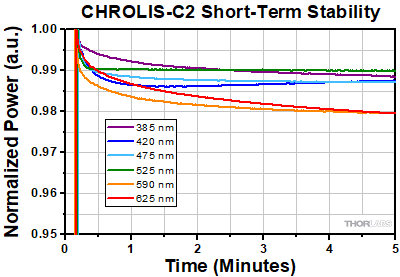

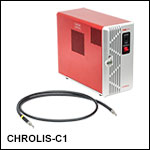
 Zoom
Zoom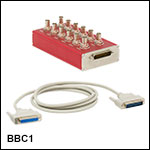
 Chrolis™ 6-Wavelength High-Power LED Sources
Chrolis™ 6-Wavelength High-Power LED Sources